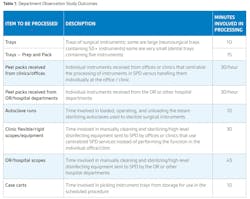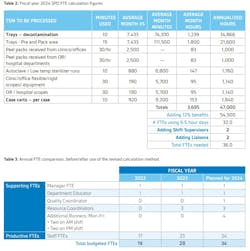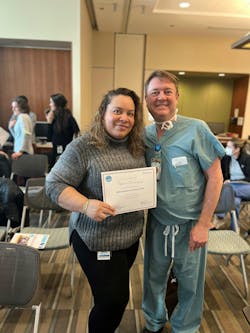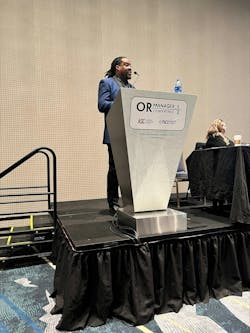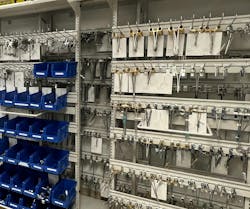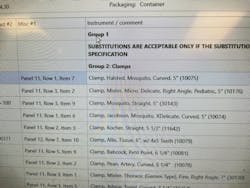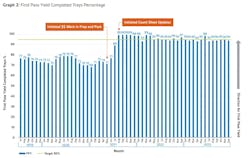The Multiplier Effect of Success in Sterile Processing
While we refer to the Sterile Processing Department (SPD) of the year, and the accomplishments of the team, it is important to recognize that a successful department is the sum of its parts, namely the individual sterile processing (SP) professionals doing the work.
The story of Ann & Robert H. Lurie Children’s Hospital of Chicago, the 2024 HPN SPD of the Year Award winner, is one of investing in individual team members’ success to drive department-wide success and, ultimately, organization-wide success in support of the hospital’s mission of a “Healthy future for every child.”
“Our hospital CEO or COO will stop by our department and thank our team for working so hard and a staff member will very earnestly say, ‘We have to take care of our children,’” said Lurie Children's Hospital Senior Director, Surgical & Procedural Services John Olmstead, MSN, MBA, CNOR, FACHE. “They take personal pride and ownership of the safety of our patients.”
What’s equally impressive are the efforts of Lurie Children’s Hospital’s SPD team members to share their best practices with other SPD teams in the greater Chicagoland area and throughout the U.S. through presentations, events, and published works.
In the words of Thomas P. Shanley, MD, President and CEO of Ann & Robert H. Lurie Children’s Hospital of Chicago, “The outcomes of this great effort have not only achieved the project goals but have also created a commitment to excellence which has extended quality enhancements far beyond the walls of the Sterile Processing Department.”
Those who judged this year’s 2024 HPN SPD of the Year nominations scored Lurie Children’s Hospital’s SPD team high across all five criteria categories: customer service, productivity, teamwork, education and training, and strategic outlook. They said of the nomination:
- “The standouts for me with Lurie Children’s Hospital are the level of detail and hard data provided throughout. I was especially impressed by the process and organizational changes that were supported by photos and documentation. Their training was also detailed and innovative.”
- “Kudos to take the time to understand the time it takes to process each piece of instrumentation, multiplied by the number of pieces processed to develop the actual staffing plan. Back to the basics. Year over year continuous improvement.”
- “Their staffing model to increase staff was great. It is a good example for others in the same predicament. The workflow redesign is critical for any department to improve workflow and productivity. The organization of their extra wall instrument storage was awesome.”
“When we started out on our transformation journey three years ago, we had a lot of odds against us, but we said success is not linear and nothing of any significance is accomplished alone,” said Lurie Children’s SPD Director W. Zeh Wellington, DNP, RN, NE-BC. “Every single person in SPD has been our inspiration. It has been an amazing journey to where we are today, but there is so much further we can go. As we tell everyone in SPD, ‘every tool, every tray, every scope that you touch, touches a child, this hospital, this community, this city, this state and it is powerful work we are doing.”
Rather than bulleting out accomplishments across the five award criteria categories, HPN offers a narrative on how Lurie Children’s Hospital’s SPD team has built upon its individual, departmental, and organization-wide successes.
Staffing for success
When Lurie Children’s SPD Leadership team first kicked off its performance improvement initiative in 2020, one of the first considerations was staffing levels, which SPD Leadership described at the time as being “woefully inadequate” to support the department’s daily tasks.
The team conducted a comprehensive time study of each major job function in the SPD. Next, they created tools to calculate the total number of full-time employees (FTE) needed to support the average daily workload, as well as allow time for staff members to engage in collaborative review with customer departments.
Lurie Children’s SPD leadership has since used this “Sterile Process Department Staffing Calculation Method” to justify staff increases each fiscal year as the volume of surgical cases and trays/instruments grows.
In the spirit of best practice sharing, they have documented their staffing calculation methodology in an article that is currently under review for publication in AORN Journal.
“As the Sterile Processing Department field has scant FTE benchmarking data, the hope is that this article may assist other SPD leaders in providing justification for adequate staffing,” Olmstead explained.
As noted by Olmstead, operational excellence demanded an increased layer of supervisory support. This led to the establishment of new positions in the SPD, shift supervisors and quality coordinators, and in turn a career ladder for highly motivated team members.
The three shift supervisors (termed resource coordinators) serve as point persons for OR/hospital stakeholder questions, vendor issues, and equipment troubleshooting. The quality coordinator is responsible for the SPD monitoring quality program and serves as a back-up resource coordinator (in case of absences).
Resource and quality coordinators routinely perform immediate education to staff involved in rarely encountered instrument issues and are readily available point persons for customers who are frustrated or confused about workflow processes.
Developing SP professionals
The Lurie Children’s SPD team is dedicated to individual staff member development with the goals of improving departmental and hospital performance and advancing the broader SP profession.
Recently, Cherie Dominguez, CSPDT, Lead Resource Coordinator, was invited by the Ann & Robert H. Lurie Children’s Hospital of Chicago Center for Quality & Safety to participate in a yearlong Improvement Scholars Program.
This interdisciplinary “learn by doing” course empowers participants to learn and apply basic quality improvement science principles to improve functions, outcomes, and processes. Each participant leads an improvement project in their own local area.
Dominguez’s project was on tracing missing instrumentation, specifically missing items in the ENT Endoscopic Sinus Tray. With a price tag of $250,000, reducing missing instruments from this tray contributes to significant savings. Her project has already met its objective in the first quarter of 2024, decreasing missing instrumentation in this tray from 11 days down to 5 within three months.
By systematically continuing to collect data and utilizing a scale method involving SPD and Surgical Services, Dominguez and team will reduce the number of missing instruments by 65% by the end of 2024. The project is now being used as a roadmap for success for other complicated instrument trays: neurosurgery, cardiology, urology, and pediatric surgery specialties.
Educating individuals
To support SP staff education and training, Lurie Children’s SPD is fortunate to have a dedicated educator in Krystal Westmoreland, BBM, AA, CSPM, CFER, CSPDT. Westmoreland facilitates full orientation for new team members on all department equipment and processes serving hospital and clinic needs. Additionally, she provides a personalized education plan for each team member that tailors the learning process to individual learning needs and speeds.
The outcome: 100% of Lurie Children’s SPD employees have passed the Healthcare Sterile Processing Association (HSPA) and Certification Board for Sterile Processing & Distribution (CBSPD) certification exams. They are the only department in the hospital that can boast 100% certification.
“Our director, manager, and leads are certified but for 100% of the staff to take ownership of their practice and say, ‘I believe in what I am doing, and I am going to earn certification to prove it,’ that is powerful,” said Olmstead.
Lurie Children’s SPD Leadership’s dedication to individual team member success is also demonstrated by its development of a training tool for department accreditation inspections. While all SP staff are taught department safety processes during their orientation, it’s no surprise newer SPD team members were nervous when they were told Joint Commission inspectors were planning to pull them aside for interviews during an upcoming inspection.
To help prepare them and alleviate their fears, Lurie Children’s SPD Leadership Team developed a formal Sterile Processing Inspection Preparation Guide. They use this tool to regularly review department processes for regulatory adherence and coach newer SPD employees in answering commonly asked questions by inspectors ahead of an inspection.
As part of the Leadership Team’s desire to share its work, they published the guide on the Association for the Advancement of Medical Instrumentation (AAMI) website on June 23, 2021. The advice about using this information to better prepare SPD staff for inspections was also published in a video blog/YouTube video by Whitman Partners on January 12, 2023.
Additionally, Lurie Children’s SPD Director W. Zeh Wellington, DNP, RN, NE-BC and Manager Charles Williams, CBSPD, gave a 3-hour presentation on their SPD team building practices during the October 2022 OR Manager National Conference.
Enhancing customer service starts from within
All the performance improvement work initiated by Lurie Children’s SPD team – from education and training to productivity and efficiency – ultimately benefits end departmental customers and their patients. This is certainly true for the team’s department redesign. Poorly positioned instruments and equipment led to many unnecessary steps in tray assembly. The average time spent in hunting replacements for missing instruments was 11 minutes.
To support SP team members in accurate and efficient tray assembly, the department replaced six traditional assembly desks with modern workstations, which have adjustable height to accommodate different employees more comfortably. They also placed printers and label makers at each station.
In addition, the team redesigned the instrument backwall, with labeled locations for all instruments. They next redesigned the instrument locations in the instrument tracking system software program so team members know exactly where on the instrument wall to locate replacement instruments for trays and the corresponding instrument wall location assignment designations.
The result was a 64% reduction in time spent locating replacement instruments, from an average of 11 minutes to just 4 minutes.
Furthermore, the new staffing model and department redesign have driven significant improvement in the department’s first pass yield completed trays percentage. Prior to this work, the percentage of trays that were filled per the tray contents instrument sheet hovered around 75%, on average.
Following the performance improvements, the average trays completed at first pass reached the department’s target of 95%, often exceeding this goal. This level has been sustained despite the surgical volume growth of 2022, when average daily surgical volumes grew from 55 to 60 cases per day to 75+ cases per day.
“We listened to our team on what they needed for the department, and they were right,” said Wellington.
Collaborating with customer departments
SPD and OR team collaboration is critical to patient care quality and safety. The Lurie Children’s SPD Leadership team appointed service champions for the major operating room (OR) services to facilitate better interdepartmental communication. SPD staff who show interest in particular services are chosen as champions and given time to meet with the individual OR clinical coordinators of those services.
Coordinators review instrument tray issues with SPD service champions who in turn educate other SPD staff members on items pertinent to those services. To date, the department has established champions for cardiology, pediatric surgery, oncology, neurosurgery, and ophthalmology services.
“The days of SPD being in a silo downstairs is gone,” said Wellington. ”SPD is instrumental to the success of the OR. And having SPD work with our clinical coordinators, talk with the surgeons and learn what an instrument or device is for, that is powerful work.”
They have also applied their improved customer service mindset to the hospital’s emergency department (ED). Historically, the ED team would use a set of trauma instruments and send them to the SPD in hopes of receiving them back before additional traumas appeared. In numerous instances, the wait time averaged 12 to 24 hours.
The Lurie Children’s SPD Leadership team implemented an exchange program, which effectively eliminates turnaround time. They arrange duplicate instrument sets commonly used in trauma cases in the SPD. Following a case, an ED team member transports the used instruments to the SPD and is given a replacement tray upon receipt.
Sharing best practices in Chicagoland and beyond
Throughout all their initiatives, Lurie Children’s SPD team has demonstrated its desire to share best practices with other healthcare organizations. Last year, the SPD Leadership team launched a program to facilitate collaboration among Chicago-area SPDs. Olmstead summed up the spirit behind it when stating, “While businesses may compete, SPD professionals all face the same competitor: infection.”
On January 27, 2023, the Lurie Children’s SPD team held its Chicago SPD Forum Luncheon where they hosted the first ever Sharing, Promoting and Discussing Forum. In attendance were SP leaders from Advocate Christ Medical Center, Rush University Medical Center, Northshore University HealthSystem, Northwestern Memorial Hospital, and Prentice Women’s Hospital. Lunch was provided by a national vendor, and attendees engaged in conversations on opportunities and barriers to operations success.
The event was such a success that Lurie Children’s SPD Leadership team has decided to make it an annual event.
“We reached out to the community but didn’t know if anyone would show up. It turned out, everybody showed up,” recalled Olmstead. “If people want to benefit from what we are doing, we want to benefit from what they are doing as well.”
Looking ahead
Never content to rest on their laurels, the Lurie Children’s SPD team has in place a strategy for their future, which aims to leverage the superior education and training of the team to better support the growth strategy of the hospital. Key initiatives in 2024 include:
- Analytics: Development of an official SPD dashboard that will be reported monthly to surgical and hospital leadership, along with other operational dashboards such as the emergency department, infection prevention, and inpatient length of stay. The dashboard will be populated by a combination of electronic databases and will provide an instant summary of improvement activities.
- Clinic support: Lurie Children’s Clinical Services cover a host of physician offices across the Chicagoland area and serves an average of 2,400 patient visits per day. The larger clinics have built functional procedure rooms where minor examinations and surgical procedures are performed. The SPD team is centralizing the processing of used instruments at surgical department hubs. After sterilization, instruments are repackaged and returned to their respective clinic locations. Additionally, the SPD educator is serving as a regional consultant, providing education and direction for appropriate handling and storage for surgical instruments.
- ASC expansion support: The SPD Leadership team is also an integral part of the Ambulatory Surgery Center (ASC) Expansion Project. Due to maximum capacity constraints at the main hospital’s 21 ORs, hospital administration is coordinating with surgeons to double the number of patients treated in the northern and western ASCs, thereby freeing up valuable downtown OR time that will allow the reduction of back-logged surgery patients. This increase in ASC volume brings a host of instrument supply and processing issues, so the weekly consultation between ASC and SPD leadership will be critical to the successful provision of surgery services in those centers.
“I want SPD to be a competitive advantage,” said Olmstead. “It is not just a service we provide but a bonus. I feel like it is now but with just a couple of things we have planned moving forward, the case will be stronger.”
A footnote to the story
The Lurie Children's SPD team submitted their nomination to HPN at the time when “the damaging effects of the January 31, 2024 cyber-attack had disabled all computer networks at Lurie Children's Hospital and associated clinics and ambulatory surgery centers.”
They had no access to the hospital’s electronic medical record (EMR) system; no communication between the EMR and associated partner programs, including their instrument tracking system; and no telephone access or Wi-Fi operated telephone access – communication was relegated to walkie-talkie and cell phone text messages.
Despite these challenges, the Lurie Children's SPD team, led by Department Manager Charles Williams and Resource Coordinator Cherie Dominguez instituted manual processes to meet all needs of the OR and hospital including:
- Implementing a manual double-check process to fill case cart needs minus the EPIC-SPM Preference Card interface information.
- Implementing a revised double-check method to reach manufacturer instruction for use (IFU) information should it be necessary to review.
- Innovating a method to print and make available all department policies for staff review.
- Implementing a series of paper logs to record all safety and biologic testing done to support sterility expectations.
“Charles and his team had to convert to 100% paper, no preference cards. I don’t know how they did it,” said Olmstead. “We do complex surgeries here and there has not been a single quality or safety issue or even delay from SPD during this cyberattack.”
About the Author
Kara Nadeau
Senior Contributing Editor
Kara Nadeau is Sterile Processing Editor for Healthcare Purchasing News.

